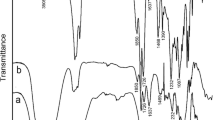Abstract
Synthesis and structural characterizations of p-bromobenzoate and p-phenylbenzoate of cellulose were carried out. Cellulose derivatives were synthesized by esterification and Suzuki–Miyaura coupling. p-Bromobenzoylation produced 75 % yield by treating a mixture of microcrystalline or kraft cellulose, and p-bromobenzoyl chloride at 80 °C in 1-N-butyl-3-methylimidazolium chloride (Bmim)[Cl] for 2 h. The effects of reaction time, temperature and molar ratio of p-bromobenzoyl chloride/anhydroglucose unit on degree of substitution (DS) value of cellulose p-bromobenzoate were investigated. Cellulose p-bromobenzoate was then coupled with phenyl boronic acid with 87 % yield using standard Suzuki–Miyaura coupling conditions in dimethyl sulfoxide (DMSO). The structure as well as the properties of the obtained product was characterized using different analytical tools such as Fourier transform infrared (FT-IR) spectroscopy, nuclear magnetic resonance (NMR) and thermogravimetric analysis (TGA).






Similar content being viewed by others
References
Heinze T (1998) New ionic polymer by cellulose functionalization. Feature article. Macromol Chem Phys 199:2341–2364. doi:10.1002/(SICI)1521-3935(19981101)199:11<2341:AID-MACP2341>3.0.CO;2-j
Edgar KJ, Buchanan CM, Debenham JS, Rundquist PA, Seiler BD, Shelton MC, Tindall D (2001) Advance in cellulose ester performance and application. Prog Polym Sci 26:1605–1688. doi:10.1016/S0079-6700(01)00027-2
Fulkerson B, Mench WJ (1958) Preparation of nitrogen containing cellulose derivatives. United states patent office 2861068 A. Serial No 619,681
Fulkerson B, Mensch WJ (1963) Process for preparing nitrogen containing cellulose derivatives. US Patent 3089870 A
Hiatt GD, Mench JW, Fulkerson B (1964) Amination of cellulose acetate chloroacetate. Preparation and properties of cellulose acetate N, N-diethylamino acetate. Ind Eng Chem Prod Res Dev 3:295–299. doi:10.1021/i360012a009
Nadeau GF, Thompson CB (1957) Removable layers for film. United States. Patent office 2801191. Serial No 545,644
Okamoto Y, Yashima E (1998) Polysaccharide derivatives for chromatographic separation of enantiomers. Angew Chem Int Ed 37:1020–1043. doi:10.1002/(SICI)1521-3773
Yashima E (2001) Polysaccharide-based chiral stationary phases for high-performance liquid chromatographic enantioseparation. Chromatogr A 906:105–125. doi:10.1016/S0021-9673(00)00501-X
Tomoyuki I, Kazuma K, Katsuhiro M, Shigeyoshi K (2014) Synthesis of polysaccharide derivatives bearing bromobenzoate pendants for use as chiral auxiliaries. React Funct Polym 82:52–57
McCormick CL, Callais PA, Huchinson BH (1985) Solution studies of cellulose in lithium chloride and N, N-dimethylacetamide. Macromolecules 18:2394–2401
Turbak AF, El-Kafrawy A, Snyder FW, Auerbach AB (1981) Solvent system for cellulose. US Patent 4,302,252
McCormick CL, Callais PA, Hutchinson BH (1985) Solution studies of cellulose in lithium chloride and N,N-dimethylacetamide. Macromolecules 18(12):2394–2401
Okamoto Y, Kawashima M, Yamamoto K, Hatada K (1984) Useful chiral packing materials for high-performance liquid chromatographic resolution. Cellulose triacetate and tribenzoate coated on macroporous silical gel. Chem Lett 149:739–742. doi:10.1246/cl.1984.739
Okamoto Y, Aburatani R, Hatada K (1987) Chromatographic chiral resolution XIV Cellulose tribenzoate derivatives as chiral stationary phases for high-performance liquid chromatography. Chromatogr A 389:95–102. doi:10.1016/S0021-9673(01)94414-0
Jinming Z, Jin W, Yan C, Shengmei S, Jun Z, Jiasong H (2009) Synthesis of cellulose benzoates under homogeneous conditions in an ionic liquid. Cellulose 16:299–308. doi:10.1007/s10570-008-9260-2
Wu J, Zhang J, Zhang H, He Jiasong, Ren Q, Guo M (2004) Homogeneous acetylation of cellulose in a new ionic liquid. Biomacromolecules 5:266–268
Barthel S, Heinze T (2006) Acylation and carbanilation of cellulose in ionic liquid. Green Chem 8:301–306
Yan C, Zhang J, Jiasong H, Huiquan L, Zhang Y (2010) Homogeneous acetylation of cellulose at relatively high concentrations in an ionic liquid. Chin J Chem Eng 18:515–522
Earle MJ, Seddon KR (2002) Ionic liquids: green solvents for the future. In: Abraham M, Moens L (eds) Clean solvents: alternative media for chemical reactions and processing. ACS symposium series 819. American Chemical Society, Washington, pp 10–25
Gordon CM (2001) New developments in catalysis using ionic liquids. Appl Catal A General 222:101–117
Rogers RD, Seddon KR (2002) Ionic liquids: industrial applications for green chemistry. Am Chem Soc, Washington DC
Wasserscheid P, Welton T (2003) Ionic liquids in synthesis. Wiley-VCH, Weinheim
Qingwei Du, Yiqun L (2011) Air-stable, recyclable, and time-efficient diphenylphosphinite cellulose supported palladium nanoparticles as a catalyst for Suzuki-Miyaura reactions. Beilstein J Org Chem 7:378–385. doi:10.3762/bjoc.7.48
Miyaura Norio, Suzuki Akira (1995) Palladium-catalyzed cross-coupling reactions of organoboron compounds. Chem Rev 95:2457–2483
Sun JX, Xu F, Geng ZC, Sun XF, Sun RC (2005) Comparative study of cellulose isolated by totally chlorine-free method from wood and cereal straw. J Appl Polym Sci 97:322–335. doi:10.1002/app.21728
Chen XM, Zou HF, Ni JY, Feng S (2003) Synthesis and characteristics of composite chiral stationary phases based on cellulose derivative. J Sep Sci 26:29–36. doi:10.1002/jssc.200390010
Acemoglu M, Kusters E, Baumann J, Hernandez I, Mak CP (1998) Synthesis of regioselectively substituted cellulose derivatives and applications in chiral chromatography. Chirality 10:294–306. doi:10.1002/(SICI)1520
Goodlett VW, Dougherty JT, Patton HW (1971) Characterization of cellulose acetates by nuclear magnetic resonance. J Polym Sci Part Polym Chem 9:155–161. doi:10.1002/pol.1971.150090114
Author information
Authors and Affiliations
Corresponding author
Rights and permissions
About this article
Cite this article
El Hamdaoui, L., El Moussaouiti, M. & Gmouh, S. Preparation and characterization of cellulose p-phenylbenzoate by two-step synthesis from microcrystalline and kraft cellulose. Polym. Bull. 72, 3031–3042 (2015). https://doi.org/10.1007/s00289-015-1451-z
Received:
Revised:
Accepted:
Published:
Issue Date:
DOI: https://doi.org/10.1007/s00289-015-1451-z




